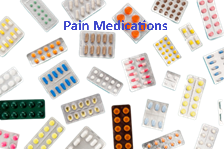Pain management
What is Pain Management? Pain management is all about helping people cope with and reduce their pain. Imagine your body has a built-in alarm system to tell you when something is wrong.
That's pain. But sometimes, the alarm can go off too much or too loud, even when there's no real danger. That's where pain management comes in.
There are different ways to manage pain, and it's not just about taking pills. Here are some common methods.
Common methods of Pain Management:
-
Medications: These are often the first line of defense. Pain relievers like Ibuprofen, Paracetamol, or stronger prescription medications like Diclofenac can help reduce pain.
But it's important to use them safely and under the guidance of a doctor, as they can have side effects.

- Pain Portals BLock: In the human body there are huundreds of pain portals (specific points) which can be used to get relief from the pain. This is a nwere technique in the management of the pain. A particular injection is given at different pain portals for diffrent types of pain. It helps in alleviating pain in muptiple conditions, eg. Low back pain, Knee pain, Pain of the ankle, sole pain; Neck pain, shoulder pain, Frozen shoulder, Tennis elbow & Golfer's elbow pain, wrist pain, Pain of Herpes Zoster, Anterior abdominal wall pain, Any type of chroic pain like due to cancer. This can also be used in case of pain due to fractures. It is also being used in case Parkinson's tremor, facial muscle twitching and more conditions.
- Prolotherapy:Prolotherapy, short for "proliferative therapy," is a medical treatment that involves the injection of a solution into damaged or weakened ligaments, tendons, or joint spaces to stimulate the body's natural healing processes.
The injected solution typically contains a substance such as dextrose, saline, or a combination of substances.
The primary goal of prolotherapy is to promote tissue repair and regeneration by inducing a controlled inflammatory response in the targeted area. This inflammatory response triggers the release of growth factors and stimulates the production of collagen and other connective tissue components, strengthening and stabilizing the injured or weakened tissues over time.
Prolotherapy is commonly used to treat a variety of musculoskeletal conditions, including:- Chronic Pain: Prolotherapy may be used to alleviate chronic pain conditions such as osteoarthritis, tendinitis, bursitis, ligament laxity, and chronic low back pain.
- Sports Injuries: Athletes and active individuals may benefit from prolotherapy to accelerate the healing of sports-related injuries, such as sprains, strains, and overuse injuries.
- Joint Instability: Prolotherapy can help strengthen and stabilize unstable joints by promoting the growth of supportive connective tissue, reducing the risk of dislocations or subluxations.
- Degenerative Conditions: Prolotherapy may be considered as a treatment option for degenerative conditions such as degenerative disc disease, where it aims to improve the integrity and function of affected spinal structures.
- Post-Surgical Healing: Prolotherapy may be used as an adjunctive therapy to promote healing and reduce pain following surgical procedures involving the musculoskeletal system.
The procedure for prolotherapy typically involves multiple injections administered directly into the affected area under local anesthesia. The number and frequency of injections vary depending on the individual's condition and response to treatment. Some people may experience temporary soreness, swelling, or stiffness at the injection site following the procedure. - Physioherapy: Sometimes, moving and exercising can actually help reduce pain.
Physiotherapists can teach you specific exercises and stretches to strengthen your body and improve your flexibility, which can lessen pain over time.
Also, there are certain machines available in Physiotherapy like Ultrasound, TENS (electrical stimulation) etc. which are used for pain relief.

- Alternative Therapies: Things like acupuncture, massage therapy, or chiropractic care can also help manage pain for some people. These methods work by targeting different areas of the body to relieve tension and promote relaxation.

- Mind-Body Techniques: Your mind can play a big role in how you experience pain. Techniques like Deep breathing, Meditation, or Mindfulness can help you relax and distract yourself from the pain signals your body is sending.
- Lifestyle Changes: Simple changes like improving your diet, getting enough sleep, or reducing stress can also make a big difference in how you perceive pain. A healthier lifestyle can often lead to less pain overall.
The goal of pain management is not necessarily to completely eliminate pain, but rather to reduce it to a level where it's more manageable and doesn't interfere too much with your daily life. It's often about finding the right combination of treatments that work best for you, and that might take some trial and error. But with the help of healthcare professionals, most people can find relief from their pain and improve their quality of life.

